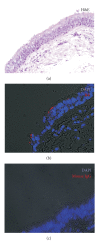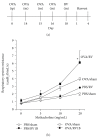Rhinovirus-Induced Exacerbations of Asthma and COPD
- PMID: 24278777
- PMCID: PMC3820304
- DOI: 10.1155/2013/405876
Rhinovirus-Induced Exacerbations of Asthma and COPD
Abstract
Over the past two decades, increasing evidence has shown that, in patients with chronic airways disease, viral infection is the most common cause of exacerbation. This review will examine the evidence for viral-induced exacerbations of asthma and chronic obstructive lung disease and the potential mechanisms by which viruses cause exacerbations. Attention will be focused on rhinovirus, the most common cause of respiratory exacerbations. Exacerbations due to rhinovirus, which infects relatively few cells in the airway and does not cause the cytotoxicity of other viruses such as influenza or respiratory syncytial virus, are particularly poorly understood. While the innate immune response likely plays a role in rhinovirus-induced exacerbations, its precise role, either adaptive or maladaptive, is debated. Because current treatment strategies are only partially effective, further research examining the cellular and molecular mechanisms underlying viral-induced exacerbations of chronic airways diseases is warranted.
Figures



References
-
- Halperin SA, Eggleston PA, Hendley JO, et al. Pathogenesis of lower respiratory tract symptoms in experimental rhinovirus infection. American Review of Respiratory Disease. 1983;128(5):806–810. - PubMed
-
- Tyrrell DAJ, Parsons R. Some virus isolations from common colds. III. Cytopathic effects in tissue cultures. The Lancet. 1960;1(7118):239–242. - PubMed
-
- Stott EJ, Heath GF. Factors affecting the growth of rhinovirus 2 in suspension cultures of L132 cells. Journal of General Virology. 1970;6(1):15–24. - PubMed
-
- Papadopoulos N, Sanderson G, Hunter J, Johnston S. Rhinoviruses replicate effectively at lower airway temperatures. Journal of Medical Virology. 1999;58:100–104. - PubMed
-
- Sluder G. Asthma as a nasal reflex. The Journal of the American Medical Association. 1919;73:589–591.
Publication types
Grants and funding
LinkOut - more resources
Full Text Sources
Other Literature Sources
Miscellaneous

